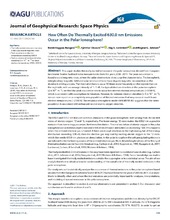| dc.contributor.author | Kwagala, Norah Kaggwa | |
| dc.contributor.author | Oksavik, Kjellmar | |
| dc.contributor.author | Lorentzen, Dag Arne | |
| dc.contributor.author | Johnsen, Magnar Gullikstad | |
| dc.date.accessioned | 2018-03-01T15:07:52Z | |
| dc.date.available | 2018-03-01T15:07:52Z | |
| dc.date.issued | 2018-01 | |
| dc.Published | Kwagala NK, Oksavik K, Lorentzen DA, Johnsen MG. How Often Do Thermally Excited 630.0 nm Emissions Occur in the Polar Ionosphere?. Journal of Geophysical Research - Space Physics. 2018;123(1);698-710 | eng |
| dc.identifier.issn | 2169-9402 | en_US |
| dc.identifier.issn | 2169-9380 | en_US |
| dc.identifier.uri | https://hdl.handle.net/1956/17447 | |
| dc.description.abstract | This paper studies thermally excited emissions in the polar ionosphere derived from European Incoherent Scatter Svalbard radar measurements from the years 2000–2015. The peak occurrence is found around magnetic noon, where the radar observations show cusp-like characteristics. The ionospheric, interplanetary magnetic field and solar wind conditions favor dayside magnetic reconnection as the dominant driving process. The thermal emissions occur 10 times more frequently on the dayside than on the nightside, with an average intensity of 1–5 kR. For typical electron densities in the polar ionosphere (2 × 1011 m−3), we find the peak occurrence rate to occur for extreme electron temperatures (>3000 K), which is consistent with assumptions in literature. However, for extreme electron densities (>5 × 1011 m−3), we can now report on a completely new population of thermal emissions that may occur at much lower electron temperatures (∼2300 K). The empirical atmospheric model (NRLMSISE-00) suggests that the latter population is associated with enhanced neutral atomic oxygen densities. | en_US |
| dc.language.iso | eng | eng |
| dc.publisher | American Geophysical Union | en_US |
| dc.relation.uri | http://onlinelibrary.wiley.com/doi/10.1002/2017JA024744/abstract | |
| dc.rights | Attribution CC BY-NC-ND | eng |
| dc.rights.uri | http://creativecommons.org/licenses/by-nc-nd/4.0/ | eng |
| dc.title | How Often Do Thermally Excited 630.0 nm Emissions Occur in the Polar Ionosphere? | en_US |
| dc.type | Peer reviewed | |
| dc.type | Journal article | |
| dc.date.updated | 2018-01-30T08:34:38Z | |
| dc.description.version | publishedVersion | en_US |
| dc.rights.holder | Copyright 2017 The Author(s) | en_US |
| dc.identifier.doi | https://doi.org/10.1002/2017ja024744 | |
| dc.identifier.cristin | 1536721 | |
| dc.source.journal | Journal of Geophysical Research - Space Physics | |
| dc.relation.project | Norges forskningsråd: 223252 | |

